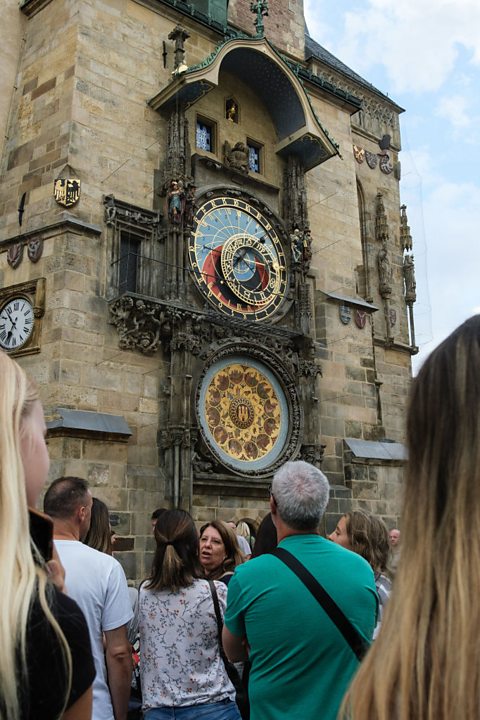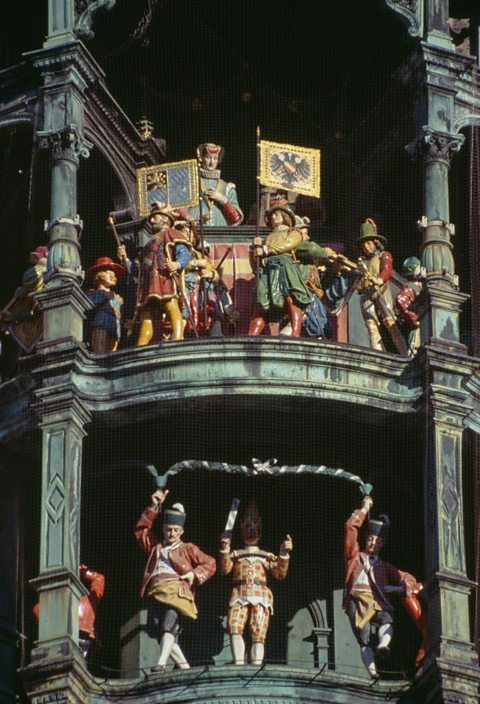ItÔÇÖs been centuries since the first public clocks were built in towns, cities and settlements around the world.
How do we know this? Well, itÔÇÖs the clocks themselves that have helped us keep track of the time thatÔÇÖs passed. These large-scale timepieces were erected for various reasons, such as helping citizens know when to gather for worship or other important events.
They may be practical, but clocks can also be beautiful pieces of engineering and design too. Step back in time with ┤¾¤¾┤½├¢ Bitesize as we select some of the most remarkable clock towers that strike the hour for everyone watching.

Zytglogge clock tower, Switzerland
Swiss timing is a regular feature at major sporting events, but a more civic example can be found in the nationÔÇÖs capital Bern. The Zytglogge tower was built more than 800 years ago, in 1191, when the city was smaller, with the clock standing at its west gate.
For its first 300-or-so years, the clock looked a little more basic than it does today. In 1530, the astronomical clock workings were added further down the structure.
Tourists regularly gather at Zytglogge in the moments before a new hour strikes. This is when a parade of mechanical figures appear, including bears, a rooster, jester and an appearance by Chronos, the Greek god of time.
ItÔÇÖs also possible for extra curious visitors to take a tour inside the tower and get a closer look at the medieval workings - as well as climbing the 130 steps to the top for a view across the city.

Peace Tower, Canada
Just as the Elizabeth Tower housing the Big Ben bell is a focal point of the UKÔÇÖs Houses of Parliament, its Canadian equivalent, the Peace Tower, in the capital city of Ottawa, Ontario, also has an impressive time-telling feature.
ItÔÇÖs a tall one too. Officially, it is a campanile, a free-standing bell tower connected to the main building. Designed by the architect John Andrew Pearson, it was inaugurated in July 1927 and stands 91m tall. There are four clock faces, with prominent gargoyles positioned directly below them.

Within the Peace Tower structure is a 53-bell A set of bells that can be played either by hand or by mechanical means, such as an organ., dedicated to the Canadian forces who served in the World War One. There is a space within the tower dedicated to those who gave their lives in the conflict.
On the day of its inauguration, the news report surrounding the event was the first ever national radio broadcast in Canada. The carillon bells will be silent for the next few years, however. Vital restoration work is taking place on them, with the aim of all work being completed in time for its centenary in 2027.

Astronomical Clock, Czech Republic
Clocks involving mechanical figures often tell a story. In Prague, the astronomical clock set into the Old Town Hall Tower shows the procession of the Twelve Apostles, as the hour strikes from 9am to 11pm.
A tower was added to the hall in the Old Town Square in the 14th Century. In 1410, the clockmaker Mikuláš of Kadaň devised a mechanism that could be added to it. Prague was a multicultural city and it was intended that this clock could be read by anyone, whichever method they used. A calendar element was added in 1490, which moved forward a day on the strike of midnight.
In 1659, the clock underwent repairs and it is believed that the moving figures were incorporated into the clock at this time. Figures on the clock include a skeleton, a vain man carrying a mirror, philosopher, astronomer and stone angel. A golden rooster was added to the clock in 1882, which makes a crowing sound created by a set of bellows.
The astronomical clock has been through many periods of repair and restoration since the 15th Century. The most serious damage came from an incendiary shell destroying much of the clock's workings at the end of the Second World War. It was back in operation again by 1948 and modifications continued through the second half of the 20th Century, including setting the clock to Central European Time (CET) and replacing and repainting the figurines.

Rajabai Clock Tower, India
Sir Gilbert ScottÔÇÖs architectural portfolio included the Albert Memorial in LondonÔÇÖs Hyde Park, rebuilding and restoration work at Westminster Abbey, and the grand Midland Hotel at St Pancras Station.
His work wasnÔÇÖt restricted to the United Kingdom. In March 1869, the foundation stone was laid for the Rajabai clock tower in Mumbai, India. Part of the cityÔÇÖs university campus, the blend of Victorian and Gothic architecture is modelled on the clock tower of LondonÔÇÖs Houses of Parliament. The name of the tower comes from the man who funded it, Premchand Roychand, the founder of the Bombay Stock Exchange. He asked that the tower bore his motherÔÇÖs name.

Rajabai was built using Kurla stone, readily available in Mumbai, and includes a series of stained glass windows. The clock tower sounds out a tune every 15 minutes these days, although when it was built during the time of the British Empire, the sounds would often alternate between God Save the King and Rule Britannia, among other compositions.
Gilbert Scott was one member of a respected family of architects. His grandson, Giles, was not only responsible for the tiny-yet-unforgettable red telephone box, but also the massive Liverpool Cathedral, the fifth largest in the world.

Munich Glockenspiel, Germany
In 1908, a new clock feature was added to the town hall in MunichÔÇÖs Marienplatz square.
Another example of a carillon, the Glockenspiel draws crowds at 11am and noon each day due to the remarkable performance played out by a series of figures on the clock tower.
While different tunes play on the clockÔÇÖs 43 bells, spectators can see a royal wedding, dance and jousting tournament all played out via the mechanics of the towerÔÇÖs workings.
Split into two levels, the upper deck of the Glockenspiel tells the story of the 1568 wedding of Duke Wilhelm V and Renata of Lorraine. It was a spectacular affair, with around 3,500 horses given the job of collecting the bride for the ceremony alone. There arenÔÇÖt quite so many steeds represented on the Glockenspiel. A jousting match - part of the wedding celebrations - is included in the movement on the top level, where the competitor from Bavaria always beats their opponent from France.
Below this, the figures take part in a dance known as the Sch├ñfflertanz. Performed by coopers (barrel makers), it is said that the dance was first performed to let MunichÔÇÖs residents know they were no longer under threat from plague. A special performance takes place at 9pm each day. Then, two sections which are inactive for the rest of the day, reveal the Angel of Peace and a night watchman, sounding the time of the cityÔÇÖs evening curfew on their horn (if youÔÇÖre visiting Munich, thereÔÇÖs no need to panic if you hear this - the curfew is no longer recognised).
The Glockenspiel is now powered by solar electricity. The programme of music played by the bells is also updated throughout the year.
This article was published in January 2023

Four places of worship built in remarkable places
Malaysia's 'floating' mosque, cliffside temples in Bhutan and a French church housed within a tree

The mind-boggling time quiz
Famous historical events that will mess with your perception of time.

Why do we turn the clocks forward?
We get one hour less in bed and brighter evenings. But why?
